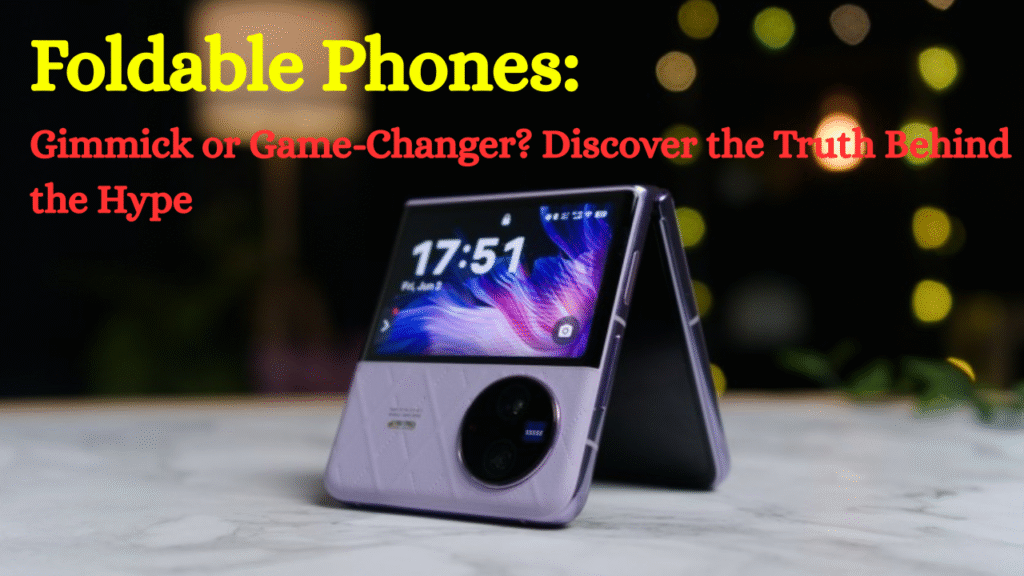
The smartphone industry is no stranger to innovation, but few advancements have stirred as much debate as foldable phones. Are they the future of mobile technology, or just an expensive party trick? With big players like Samsung, Huawei, and Google investing heavily in foldable tech, it’s time to take a deeper look. Let’s unfold the real story—what makes foldables a breakthrough, what holds them back, and whether they’re worth your money.
The Evolution of Foldable Phones: From Concept to Reality
Foldable phones first emerged as concept devices, tantalizing users with the dream of a tablet-like screen that fits in your pocket. Fast forward to today, and brands like Samsung (Galaxy Z Fold and Flip), Huawei (Mate X), and Motorola (Razr) have turned concept into reality. These phones combine flexible OLED displays with complex hinge mechanisms, offering users a hybrid experience between a smartphone and a tablet.
Why Foldables Seem Like the Future
- Larger Displays, Pocket-Sized Form Factor
The primary appeal of foldable phones is screen real estate. You get a tablet-sized display without needing to carry one. For multitaskers, creatives, and content consumers, this is a massive benefit. - Multitasking on Steroids
Foldables like the Galaxy Z Fold allow for seamless multitasking—running up to three apps side-by-side. That’s a productivity dream for professionals and tech-savvy users. - Cutting-Edge Innovation
Foldables push the envelope in design and engineering. With water-resistant foldables, improved hinges, and longer-lasting screens, brands are overcoming early flaws. It’s not just a phone; it’s a glimpse into the next decade of tech.
But Here’s Why Some Still Call It a Gimmick
- Durability Concerns
Despite advancements, foldables are more fragile than traditional phones. The foldable screens are softer and more prone to damage, and hinges can wear over time. - High Price Point
Foldable phones are premium devices with premium price tags. Many cost over $1500, pricing them out of reach for the average user. - App Optimization
Many apps aren’t fully optimized for foldable screens, leading to awkward UI experiences. Developers are still catching up to this form factor. - Battery Life
With dual displays or larger fold-out screens, power consumption increases. Some foldables still lag behind in battery endurance compared to flagship slab phones.
Foldables at a Glance: Pros and Cons Table
| Feature | Foldable Phones | Traditional Smartphones |
|---|---|---|
| Display Size | Large, tablet-like when unfolded | Fixed, smaller display |
| Portability | Compact when folded | Always the same size |
| Durability | Less durable, hinge wear | More robust over time |
| Price Range | $1,000 – $2,500+ | $300 – $1,500 |
| Software Optimization | Still improving | Highly refined |
| Battery Life | Often shorter | Longer, more efficient |
Who Should Buy a Foldable Phone?
- Professionals who multitask and need a larger screen for productivity
- Tech enthusiasts who want to stay on the cutting edge
- Content creators who can benefit from tablet-style visuals in a pocketable form
Who Should Skip Foldables (for Now)?
- Budget-conscious users who need better value for money
- Rough users who prioritize durability and rugged design
- Those who prefer simplicity and reliability over flash and flair
The Future of Foldables: What’s Coming Next
The foldable market is expected to grow exponentially by 2027, with improvements in durability, price reduction, and software optimization. Companies are exploring rollable displays, triple-fold mechanisms, and even foldable laptops. As innovation continues, the line between phone, tablet, and laptop could blur entirely.
Overview Table: Foldables in 2025
| Aspect | Current Status | Future Outlook (2026–2027) |
|---|---|---|
| Price | Premium ($1,000+) | Expected to decrease gradually |
| Durability | Improved, but still fragile | Hinges and screens to get stronger |
| App Support | Inconsistent, improving | Likely to see full optimization |
| Battery Life | Moderate | Efficiency improvements expected |
| Market Adoption | Niche but growing | Could become mainstream by 2027 |
| Manufacturer Support | Led by Samsung, Huawei, Google | Led by Samsung, Huawei, and Google |
Conclusion: Hype or a Legitimate Leap Forward?
Foldable phones are not just a gimmick—they represent an evolution in how we interact with our devices. However, they’re not for everyone—yet. If you’re willing to invest in innovation and can handle a few quirks, foldables offer a unique and powerful experience. But for the average user, the traditional smartphone still holds more practical value… for now.
Top 3 FAQs – Answered in a Flash
Q1: Are foldable phones more fragile than regular phones?
Yes, especially the screen and hinge, though durability has improved in recent models.
Q2: Will foldable phones get cheaper soon?
Likely yes. As the tech matures and production scales, prices are expected to drop by 2026.
Q3: Do foldables support all apps normally?
Not always. Some apps may not scale perfectly, but optimization is improving with each update.

